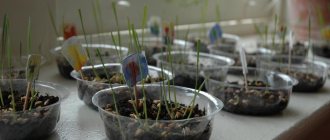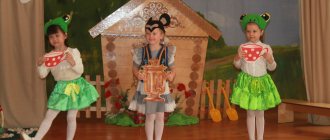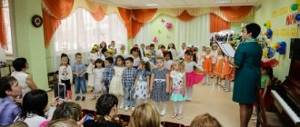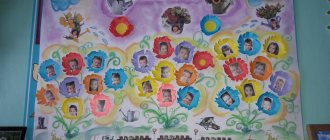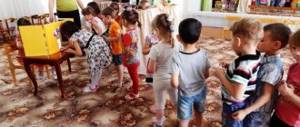Art Corner
To properly organize children's activities, zoning of space in the group room is provided. That is why you can find various themed corners such as “Kitchen”, “Hospital”, “School”, etc.
Some kindergarten teachers place the theater corner in a separate structure. However, more often we see large art centers where various subsystems are combined. They can combine a circle of drawing, music, manual labor and theater. This saves space. And most importantly, the basic principles of the theater corner are observed.
Floor theater
Floor theater uses puppets. Making them yourself is quite difficult, so most often they are purchased in specialized stores. Due to this feature, this type of theatrical activity is rarely carried out in kindergartens. But it is the puppet theater that evokes a storm of emotions and delight in preschoolers. Since children do not yet understand the mechanism of action of such dolls, children imagine that the toys themselves have “come to life”. It is this element of “miracle”, “fairy tale” that contributes to the emergence of positive emotions in preschoolers.
Requirements for a creative center
Since the theater corner in a kindergarten group is the most important element of the artistic and aesthetic development of children, it must comply with the following principles:
- The principle of mobility. It is necessary to provide for the possibility of combining different corners and zones of the kindergarten group, as well as the transportability of theater paraphernalia.
- The principle of material replacement. It is necessary to constantly update the repertoire, scripts, scenery and other paraphernalia. This will depend on many factors, for example, the time of year, the age of the children, their interest, software, topics of classes, etc.
- The principle of multifunctionality. It implies that the same attribute can perform multiple tasks.
- The principle of aesthetics. Theater should develop children's sense of taste.
- The principle of accessibility. The equipment of the theater corner should be suitable for children by age and coincide with their areas of current and immediate development.
Arrangement of the art center
Furniture for a theater corner in a kindergarten can be made independently from available materials, or it can be made to order. The main components of the theater are the screen and the mummers' corner. The rest of the attributes differ depending on the age of the children.
For example, for children of primary preschool age, props are used to stage fairy tales known to children (“Teremok”, “Turnip”, “Ryaba Hen”, etc.), namely: a flannelgraph for displaying pictures and a mini-screen for a tabletop theater. You can use simple costume elements such as a scarf, umbrella, beads or hat.
To equip the corner in the middle group, all kinds of masks are used. These can be animals, fairy-tale characters, and even images of vegetables. Paraphernalia used is a large screen for staging performances and a display case for costumes.
Children in the older group of kindergarten can use home-made decorations in productions. This increases children's interest in preparing the performance. It is recommended to have props available for staging 4-5 diverse fairy tales. This will give children a choice. They can also come up with their own fairy tales and performances based on these materials and decorations, thus developing creative thinking.
Message “Design of a theatrical activity center in a preschool educational institution”
Theatrical and play equipment: large and small screens, simple decorations, including those made by children, a rack-hanger for costumes;
Costumes, masks, wigs, attributes for staging 4-5 fairy tales;
Puppets and attributes for playing out the same fairy tales in various types of theater: finger theater, bibabo puppets, shadow theater of figures and masks, cane puppets, etc.
Audio recordings of musical works,
recording sound and noise effects to create a background during theatrical and play activities.
For children 6-7 years old, the gaming material of theatrical games meets basically the same requirements as at the previous age stage. However, puppets with a basic control system are additionally recommended here; soft, on strong threads.
In modern kindergartens, where space is quite limited, it can be quite difficult to allocate separate places for corners (theater, outside world, etc.). Therefore, the educator can combine educational centers into a complex. For example, for the areas of theater, visual arts and music, you can organize a single artistic and creative corner. At the same time, we must not forget that the subject content must comply with a number of principles:
mobility
(materials for music classes can be illustrative and for theatrical performance);
security
turnover
(the contents of the corner should vary depending on the goals of educational work in a given month, the direction of the group’s specialization, the time of year, the interests of the children, the degree of wear and tear of the materials);
accessibility
(all children have the same rights and responsibilities related to the use of the attributes of the theater corner);
aesthetics
(the center itself and all its components must look beautiful, be clean and tidy)
The theater corner, which has everything necessary for the relevant activity, allows you to create a comfortable environment in the group for the development of the creative abilities of students. Theatricalization is a special area of the educational program for preschool institutions, because it gives children the opportunity not only to explore the world around them, but also to learn to live in harmony with it. In addition, theatrical performances help children become more self-confident, which is also important for their personal growth - which means that a kindergarten cannot be without a theater corner.
Bibliography
Antipina A.E. Theatrical activities in kindergarten. - M.: TC Sfera, 2006.
Makhaneva M.D. Theatrical activities in kindergarten. - M.: Creative Center Sphere, 2001.
Migunova E.V. Organization of theatrical activities in kindergarten: Educational and methodological manual. — Veliky Novgorod: NovSU named after. Yaroslav the Wise, 2006.
Types of representations
The theater corner in kindergarten involves not only learning the script and staging a performance. There are many types of performances in which children will develop not only imagination and creative thinking, but also fine motor skills, associations and even tactile sensitivity.
In kindergarten, the theater corner, as a rule, consists of several blocks. When forming them, you need to take into account the age factor. An art center may include the following types of theater:
- Finger.
- Desktop.
- Theater toys: soft, knitted, cone, etc.
- Puppet.
- Parsley Theater.
- Theater of Transformation.
Performances using puppets are especially varied. Props can be:
- Puppets.
- Dolls with a “living” hand.
- Mitten gloves.
- Doll people.
- Homemade products on a thread or elastic band.
- Cane puppets.
It is recommended to alternate between different types of creative activities so as not to cause satiety in children.
Theater corner in kindergarten and its design
The theater corner is a component of the general atmosphere of the group, created with the aim of uniting children and developing new skills and competencies in them.
The classic theatrical corner consists of several components:
- illustrations, photographs, paintings, etc.;
- toys;
- screens (which are used as decorations, as well as curtains);
- additional props (bells, bells, cars);
- decorative elements;
- outfits and masks;
- demonstration stands;
- library sector.
Illustrations and toys are important in the corner
The theater corner should be equipped in such a way as to make theatrical activities effective.
For your information. When designing a theater corner, it is fundamentally important to take into account the age group of children, take into account the group and personal characteristics of children, their interests and aspirations.
Junior group
In nurseries and the first group of kindergarten, it is better to pay attention to finger theater. It requires dolls that fit on each child’s finger and develop fine motor skills well.
Almost any material can be used to make such dolls. It could be fabric, felt, paper, polymer clay.
The next stage, which occurs at the junior group level, is teaching children how to properly play with toys on the table surface, as well as developing finger theater skills. The task of this stage is to train the coordination of the child’s movements and further develop his fine motor skills.
For your information . In order to make such a prop yourself, you will need cones made of hard paper or cardboard. In addition, the use of bibabo (a set of glove puppets) seems advisable at this age.
Children in this age group should do:
- finger theater;
- tabletop theater;
- theater of soft and knitted toys;
- theater of toy-cones.
Middle group
Children need to hone all previously acquired skills, so classes started in previous years should not be interrupted. At the same time, it is necessary to introduce new types of theatricalization. At this stage of child development, the theater of spoons is appropriate. To “cook” the characters in the productions, ordinary plastic utensils are used here. At the same time, the theater screen began to be used.
The topic of migratory birds in spring at art lessons in preparatory groups
For your information . You can introduce children to dolls on the gapite. Hapit is a wooden rod. These props will help kids learn the basics of puppeteering.
During centralization classes, children in the middle group are given a more complex task. They need to bring their own movements and the plot of the production into agreement. The theater begins to represent an action that has a clear storyline and meaning. This requires the baby to reach a new level of development of coordination and motor skills.
Options for middle group children:
- finger theater;
- tabletop theater;
- dolls on gapits;
- glove puppets.
Senior kindergarten group
During training in the senior group, it is recommended to start using puppets during theatrical classes. These dolls are characterized by an unusual way of bringing them into a state of movement. A special thread holder (cross) is responsible for this process. It is to it from below that the “body” of the toy is directly attached.
In addition, special attention should be paid to the process of voicing the characters, because the goal of theatrical classes at this stage is to teach children to use vocal intonations to convey emotions.
The optimal options are:
- finger theater;
- glove puppets;
- puppets.
In the preparatory group
At this stage, the child already becomes a “real” actor. He must transform into his hero by reproducing his manner of moving, speaking, and behaving. The child must learn to imitate the voice and correctly express the emotions and experiences of the hero. For a more accurate and real transformation, children dress up in stage costumes.
Life-size puppets develop well
At this age, it is possible to use a wide range of props, for example:
- finger puppets;
- changelings;
- glove puppets;
- puppets;
- life-size puppets;
- cane dolls.
At the same time, it is worth taking into account a certain convention of the above distribution of activities in the theater club depending on the age group of the child.
For your information. It is necessary to take into account the general level of the group, the specifics of the child, and the presence of interest in a certain type of theatrical activity.
It is a completely normal practice for children of middle and senior age to participate in costume performances. Glove puppets can be successfully used in theatrical performances even for children 5–6 years old.
Material for decoration
To create a theater corner in a kindergarten with your own hands, any available means are suitable. Most often used:
- milk cartons and other tetrapacks;
- carton boxes;
- plastic bottles;
- kinder surprises;
- gloves, mittens;
- shawls, stoles, scarves, scarves;
- wool threads;
- papier mache;
- scraps of unnecessary fabric;
- paper and cardboard;
- disposable tableware;
- cans;
- cup holders;
- socks and unnecessary clothing;
- foam rubber and polystyrene;
- wooden spoons;
- salty dough;
- natural materials, etc.
Any item can be adapted for decoration. However, the main thing is to take precautions. The paraphernalia that the child will constantly use in his theatrical activities must be safe.
How to make a theater corner passport
The theatrical corner, or rather, its design, must be carried out in accordance with federal state educational standards (abbreviated as Federal State Educational Standards). Designing a theater corner in a kindergarten according to the Federal State Educational Standard requires compliance with certain standards.
The Federal State Educational Standard prescribes that the theatrical corner should provide:
- development of abilities to remember information;
- development of the child’s thought processes;
- development of sociocultural concepts in children;
- strengthening speech capabilities;
- physiological development;
- introduction to a culture of behavior in society;
- knowing yourself as a person.
The passport according to the Federal State Educational Standard includes eight positions. At the same time, the standard provides a detailed description of each of them:
- The inscription of the full name of the child care institution.
- Designation of the group and name of the theatrical corner.
- The authors who designed the corner.
- Name and description of zones that are part of the project. Mandatory elements are a screen and a wardrobe. Zoning of other parts occurs at the discretion of competent persons. In total, we can highlight a costume room, a dressing room, a workshop, an auditorium, a library (including the availability of video and audio materials), a screen, cabinets for storing props, and an area dedicated to the results and achievements of children in the field of theatrical performance (stand).
- Occupancy of each of the existing zones.
- Age indicators of pupils.
- A list of activities that are implemented at a specific age stage during theatrical classes.
- Various methodological developments, recommendations, templates and presentations. They mean advice regarding the frequency of appropriate activities and their duration. It also includes tasks assigned to a specific group, a list of exercises that are required to be performed during theatrical classes for representatives of a specific group.
Drawing lessons on the theme “Airplanes are flying” for the middle group
Decorating ideas
In the design of a theater corner in a kindergarten, the so-called barker doll plays a key role. This is a kind of talisman and guardian of the theater. This item can be any character from a fairy tale. It can even be fictitious, the main thing is that it is always in a visible place. It is desirable that this attribute of the theater is always in the theater corner and occupies a central position. It’s even better if he takes part in productions or acts as a spectator.
How to design a theater corner in a kindergarten? This question is asked by all beginning educators. Initially, it is necessary to make a screen, both large and small, for the tabletop theater. For this you can use any light fabric. Just hang it on a stick or baguette and secure it to a tripod. You can also use a wooden frame.
Window screens are very popular. They are universal, they can be used for both large and tabletop theaters. To make them, you need to take a sheet of thick cardboard and cut a window in it. You need to hang the curtain in the hole, and the screen is ready.
The example of decorating a theater corner in a kindergarten in the photo below shows that, with a lot of imagination, you can create a colorful and interesting “temple of Melpomene.”
Living Puppet Theater
But more often than others, a “live” puppet theater is organized in kindergarten. Such activities can be carried out as a lesson on the development of speech, the surrounding world, learning a foreign language, as well as during leisure time. In addition, a live theater production can be dedicated to a holiday, for example, Maslenitsa or New Year.
The following types of described gaming activities are distinguished:
- masque;
- theater of giant puppets.
The latter is most often carried out as a leisure activity in a preschool educational institution. The roles of giant dolls are played either by adults or older preschoolers. Younger children can only act as spectators.
Then the mask theater is suitable for children of any age. Even the youngest pupils have the opportunity to “reincarnate” into the hero of a fairy tale. The teacher can invite the children to retell a story the kids love in such an unusual way or prepare a full-fledged performance for their parents.
Preschoolers can make masks for the upcoming performance on their own under the guidance of a teacher, for example, during classes on artistic and aesthetic development or during leisure activities.
Theater and Music Center
Quite often you can find combined corners. Artistic performances have musical accompaniment. For this purpose, various tools and technical devices are provided in the theater corner.
Wooden spoons, rattles, maracas, whistles, etc. are used as factory and homemade instruments. A theater and music corner in a kindergarten can also contain noise jars (Kinder Surprise containers with various fillings), hammers made from corks, pancakes made from saw cuts, metallophones, tambourines, bells, accordions, guitars, etc. All these devices can be used to create your own soundtrack or play existing compositions. This develops a sense of rhythm in children and instills a love of music.
In older kindergarten groups, tape recorders are used to listen to music, record sound and noise effects, and watch a video library of literary works. Children in preparatory groups act out scenes accompanied by ready-made sound accompaniments, for example, audio fairy tales.
Equipment for a theater corner for the middle group
- Attributes in accordance with the content of imitation and round dance games: masks of wild and domestic animals (adults and cubs), masks of theatrical characters.
- Large folding screen, small screen for tabletop theater.
- Rack-hanger for suits.
- Costumes, masks, attributes for staging two or three fairy tales.
- Puppets and attributes for playing out the same fairy tales in various types of theater (plane on flannelgraph, rod, puppet, tabletop, glove).
- Attributes for "Colorful Tales".
- Theater of Mathematics.
- To create a musical background in the process of theatrical play activities: audio recordings of musical works, recordings of sound and noise effects, simple musical toys - rattles, tambourine, drum.
Contents of work on theatrical activities
The activities of the creative corner should have a clear focus. Therefore, you cannot simply leave children’s staged games to chance. It is necessary to constantly monitor the process of theatrical activity.
For this purpose, they watch puppet shows and conduct discussions on them, organize dramatization games, literary competitions “Guess the title”, “Guess the name of the hero”, “Remember and tell”. They act out fairy tales and stage performances based on poems. Also, be sure to perform exercises to develop expressiveness of performance.

